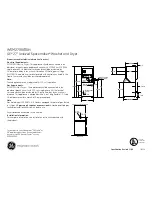
Page EN-9
Safety
Risk of scalding!
The hot washing-up water will cause
the dishes and the interior of the appli-
ance to heat up and hot steam is emit-
ted. Touching them can therefore cause
scalding.
■
Only hold the door by the handle
when opening the door. Maintain a
safe distance from the appliance in
order to avoid steam which may es-
cape.
■
Do not touch the dishes, cutlery or
the inside of the appliance imme-
diately after the dishwashing pro-
gramme has fi nished.
Trip hazard!
If the door of the appliance is left open,
it can easily become a tripping hazard.
■
Close the door after every use.
■
Only leave the door slightly open to
cool down.
Risk of damage!
Improper handling of the appliance
may result in damage.
■
Never leave the appliance unsuper-
vised for an extended period when
the tap is on.
■
During storms or when going on hol-
iday, always withdraw the mains plug
from the socket and close the water
tap.
■
If there is a risk of frost, loosen the in-
let hose and allow the water to run
off.
■
Only use regenerating salt which is
suitable for dishwashers.
■
Only add dishwasher salt immediate-
ly before the next main dishwashing
cycle, as dishwasher salt which has
overfl owed can damage the seals and
fi lters of the appliance.
■
Immediately remove any spilt dish-
washer salt with a damp towel, as
otherwise the stainless steel surface
can be damaged.
■
Ensure that the dishwasher detergent
and rinse aid are suitable for the ap-
pliance.
■
Wipe away rinse aid which has over-
fl owed immediately as otherwise it
can lead to excessive foaming which
can compromise the results delivered
by the dishwasher.
■
Do not overload the appliance.
■
Position the upper dish rack at the
highest setting if very large dishes are
in the lower dish rack to prevent ob-
struction of the upper wash arm.
The seals of the door are sensitive to oil
and grease.
■
Do not apply grease to the door seals.
The door seals can be damaged by un-
suitable cleaning agents.
■
Do not use harsh, aggressive, sol-
vent-based or abrasive cleaners.
The appliance is designed for a water
pressure of 0.4-10 bar (0.04-1.00 MPa,
40-100 N/cm
2
).
■
If the water pressure is higher than
this, install a pressure reducer. If in
doubt, enquire about the water pres-
sure with the water supply company.
















































